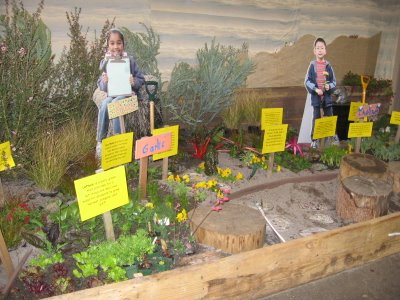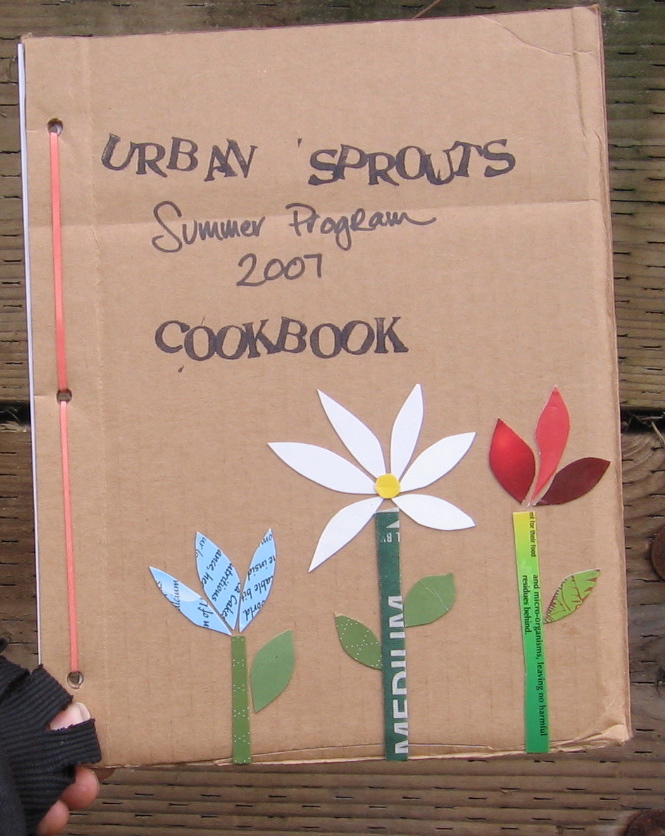skip to main |
skip to sidebar
My apologies to Britt! It’s taken me a month and a half, but I’m finally responding to this meme Britt tagged me for, to answer this question:
"What five resources - online or otherwise - would you point people to, if you wanted to give them an entry into your field of expertise?"
To become a School Garden Educator I have had to carve out my own path. I found no field of expertise to follow. The "field" is nebulous, a little here a little there, but I think now it is really taking shape.
My approach was combining several related fields, like sustainable agriculture, youth development, education and nonprofits, but I found some serious disconnection between them. Not to mention between the goals and standards for public education and the real, holistic needs of young people as they grow up.
I believe youth need to grow up connected to nature the same way that plants need to grow connected to healthy soil, full of life, not just synthesized petro-based chemicals.
Here are some of the resources I would recommend for aspiring School Garden Educators.
The new website of the California School Garden Network seems to be the most comprehensive resource so far, with lists of curriculum, contacts, trainings, funding opportunities, and policy and research citations.
Occidental Arts & Ecology Center School Garden Training, Sonoma, CA
This is an incredible 5-day training at an organic garden where you learn the basics of horticulture plus the nitty gritty of starting and sustaining a school garden. The garden basics are like a VERY condensed form of what you get at the UCSC Farm & Garden Apprenticeship, but for school garden educators. SFUSD schools serving low-income communities can go for free.
Gardening and Composting Educator Training Program (GCETP or “the Get Up Class” for short)
This training based out of San Francisco’s Garden for the Environment teaches the basics of gardening and composting (geared for urban home and community gardens) and how to teach them to others. Many of our BEST Urban Sprouts volunteers are graduates of this excellent program.
Community Network for Youth Development (CNYD) Learning Network
The Learning Network is a four month program that makes Youth Development theory real and tangible, a strong basis and justification for our work. I think we should all be thinking about and using theory to support our work, from frontline youth workers to teachers to directors—it's not just for academics!
And stay tuned for the Garden-based Education theoretical model that the amazing Michelle M. Ratcliffe is developing with support from Urban Sprouts.
And, some good books! (OK, this is more than 5)
My path to garden-based education started in two places: on a farm in rural Pennsylvania and alone in the darkest, dustiest, most hidden stacks of my school library. These classic books and writers had a huge impact on me as I plotted my career path.
The One-Straw Revolution by Masanobu Fukuoka
A Japanese scientist “converts” from scientific farming to natural farming, teaching that nature is a more efficient farmer than western science, because it’s about utilizing interconnections instead of dominating the soil with chemicals and machines.
Vandana Shiva
Again, an Indian scientist leaves the “religion” of western science to learn from nature rather than objectification in the laboratory. She shows how rural women are the best scientists, because they use their emotions and intuition –yeah, ladies! She has a lot of great books. I like Staying Alive: Women, Ecology & Development and her best title Monocultures of the Mind!
Miguel Altieri & Agroecology
Altieri’s book Agroecology is great. He’s from Chile, and I’ll never forget when I heard him speak and he said that this big Chilean island called Chiloe has more than 300 different varieties of potatoes. All on ONE island! Now that’s diversity! He writes about many traditional/indigenous Latin American farming techniques.
Training for Transformation by Anne Hope and Sally Timmel
A classic training handbook for participatory education based on Paulo Freire’s theories. Formal education so often reinforces power and oppresion, teaching that only the teacher knows best. Students have a lot to teach teachers, too!!
Since we talked today about professional development at our Rising Leaders Fellowship today, I'm tagging Sangita, Sele and Carrie to give five resources related to the inspiring work they do.
ngomeme
garden-based education
sustainable agriculture
agroecology
participatory education
Today in Ms. Boggess’s 7th grade Peer Resources class at Burbank, we compared the amount of sugar in different kinds of beverages. In order to compare we took four steps:
- We read Nutrition Facts on each bottle and found the grams of sugar in one serving size, or 8 oz.
- We calculated how many servings were in one bottle. Most bottles were 20 oz, so we used that number, and got the total grams of sugar in one bottle.
- We weighed one teaspoon of sugar (4 grams) and calculated how many teaspoons of sugar are in one bottle.
- We measured out the number of teaspoons into a plastic baggie for each beverage, so we could SEE the difference!
 Here are our totals, for teaspoons of sugar in one 20 oz bottle of different beverages:
Here are our totals, for teaspoons of sugar in one 20 oz bottle of different beverages:
Water – 0 tsp
V8 – 6 tsp
Vitamin Water – 8 tsp
Sports drink – 9 tsp
Apple juice – 18 tsp
Coke – 17 tsp
SoBe Citrus drink – 25 tsp
Sugar Limit for one entire day: 48 g or 12 tsp
Then we thought about what it would be like to eat the bag of 25 teaspoons of sugar. Yuck.
Then we talked about a few things. One, would you rather eat natural sugar that comes straight from an apple, no sugar added, instead of a coke that is full of added sugar? Or diet soda, filled with fake, chemical sugar?!
Last, we thought about what happens to you if you eat more than 12 teaspoons of sugar per day. We though you would gain lots of weight, and have trouble in class because you’d feel really hyper and then later you’d feel sick, tired and have a headache.
At the end of class we made delicious smoothies!
Congrats to all the SFUSD school and SF Green Schoolyard Alliance gardeners who created this amazing garden vignette for the SF Flower & Garden Show, held March 15-19 this year.
 It was so great to have the schools represented at this big, high profile show. And our district Educational Gardens Director, Arden Bucklin-Sporer, gave a presentation that was an inspirational pep talk for all of us school gardeners. Great job everyone!
It was so great to have the schools represented at this big, high profile show. And our district Educational Gardens Director, Arden Bucklin-Sporer, gave a presentation that was an inspirational pep talk for all of us school gardeners. Great job everyone!
Also, the SF Green Schoolyard Alliance has just produced a beautiful school garden resource directory, which you can download from SF Beautiful.
school garden
green schoolyard
 Welcome to literally the first sunny day we've had for gardening at Burbank this spring. It has been so dreary lately. I think these photos taken by the students in Ms. DeSnoo's 3rd period class capture our day quite well.
Welcome to literally the first sunny day we've had for gardening at Burbank this spring. It has been so dreary lately. I think these photos taken by the students in Ms. DeSnoo's 3rd period class capture our day quite well. The workers:
The workers:












